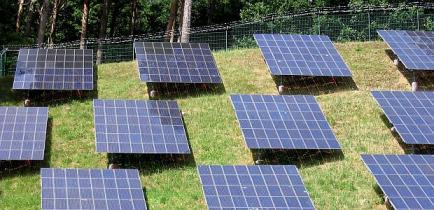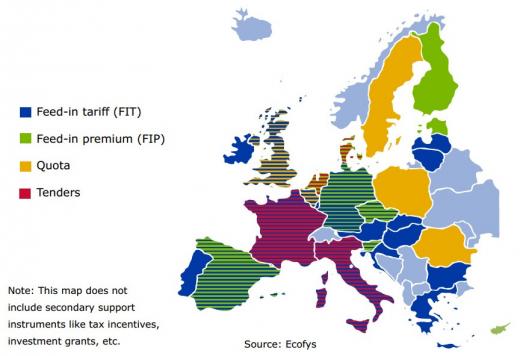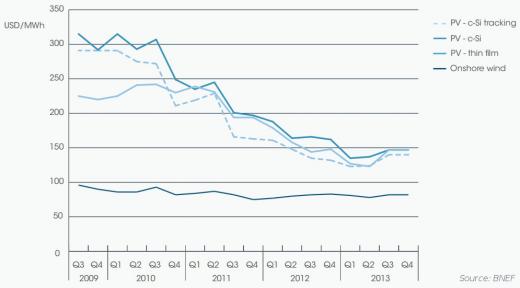Issues:
Sectors:
Keywords:
This knowledge package provides an overview of the implementation and development of European renewable energy support policies in various Member States (MS).
1.From binding national targets for 2020 to an EU wide target for 2030
With the adoption of the Renewable Energy Directive (2009/28/EC) in 2009, for the first time binding renewable energy targets for all EU MS have become effective for 2020. The overall European Union (EU) target is a 20% share of energy from renewable energy sources (RES) in the final energy consumption in 2020, as set in the 2008 decided package of energy and climate change legislation of the EU. The 20% EU-wide target is allocated among the MS, with national targets ranging from 10% for Malta to 49% for Sweden. In addition, a target of 10% renewable energy in the transport sector was set, which has to be achieved by each MS. In October 2014 however the European Council adopted the EU’s 2030 Energy and Climate framework that foresees a RES target of 27% at EU level by 2030 but no longer binding RES targets at the national level.1 The EU goal is meant to be fulfilled through Member States contributions guided by the need to deliver collectively the 27% - without preventing Member States from setting their own more ambitious national targets. What impacts this change in the target architecture will have on the respective implementing policies is yet to be seen. This knowledge package focuses, therefore, on the policy experience thus far.
1.1 Member States are free to choose means to reach national renewable energy targets
The Renewable Energy Directive (RED) demanded the submission of National Renewable Energy Action Plans (NREAPs) by each MS by 2010. Therein a detailed strategy of how the individual target is aimed to be achieved had to be presented, considering electricity, heating and cooling as well as transport. Actions and support schemes planned to be implemented by each MS have to be consistent with a number of rules with regard to administration, certification, grid access etc. However, which regulatory or supporting policies are used to achieve the RES target on the national level is left to the MS’ own discretion.
2. Renewable energy support schemes nationally
2.1. Overview of policy instruments implemented
To reach its individual RES target, a mix of different policy instruments to support the development and deployment of RES is implemented by each MS. The majority of policy instruments implemented focus thereby on the power sector, although also targets for specific RES shares in heating and cooling as well as for the transport sector have been introduced. Types of policy instruments implemented include regulatory policies, fiscal incentives as well as public financing.
Key mechanisms in national renewable energy support policies include:
- Feed-in tariffs (FIT)
- Feed-in premiums (FIP)
- Quota obligations with tradable green certificates
- Loan guarantees
- Soft loans
- Investment grants
- Tax incentives
- Tendering schemes
Key mechanisms that have been introduced by various EU MS to increase RES within the power sector are feed-in tariffs (FIT) and feed-in premiums (FIP s).
FIT guarantee continuous retail prices for RES plant operators for a given period.2 The cost for FIT can be funded through tax revenues (i.e. the public budget), or be placed on market participants such as electricity suppliers or network operators, who then socialise these costs among electricity consumers.3 FIT provide predictability and stability, both for the overall renewable energy landscape from a policy perspective and for the individual producers and investors with regard to their revenue.4
In an FIP, plant operators have to market the electricity generated directly at the electricity market and receive an additional payment on top of the electricity market price - either as a fixed payment or adapted to changing market prices in order to limit both the price risks for plant operators and the risks of providing windfall profits at the same time. The revenue risk is increased in a FIP compared to a FIT.
Furthermore, FIT as well as FIP are price instruments that do not by themselves restrict quantity. The government fixes the amount of funding available; quantity is determined by the ratio of particular technology costs and amount of feed-in tariff granted for a particular technology.
Several EU MS have also introduced quota obligations. In comparison to FIT / FIP this means that governments fix quantities and the market decides price. A minimum share of the electricity supply has to be from RES, and this share is increasing over time. Suppliers may trade certificates for electricity from RES (RES-E) if they cannot reach the minimum share with own production. The certificates have to be submitted to the competent authority. The power is sold on conventional markets.5 The main advantages of the quota obligation with tradable green certificate (TGC) markets are the high compatibility with market principles and the competitive price determination. However, high risk premiums resulting from the uncertain development of the prices of electricity and the certificates typically increase policy cost.6 Quota obligations are not only used for supporting the development of RES electricity but also for increasing renewable energy in the transport sector, thus via biofuel support policies such as blending obligations.
Another option for RES support are to use tender or auction schemes to allocate financial support to different renewables technologies and to determine the support level of other types of support schemes, such as feed-in systems, in a competitive bidding procedure. There are different ways to design an auction, but the static sealed-bid and the dynamic descending clock auction or a combination of the two have been used the most to support new renewable energy plants. Different mitigation measures exist to ensure that winning bidders effectively implement their project. Tendering is used e.g. in Denmark, the Netherlands and France.
Fiscal incentives such as grants and investment subsidies are the most popular policy mechanisms implemented to promote renewable heating and cooling.
2.1. Adjustments of policies and targets
Due to changing economic market conditions in the EU, renewable energy supporting policy mixes in each MS have run through a lot of modifications since 2009. In addition to changes in the policy mix, several MS have also changed technology-specific targets. For example, the UK added a target of 39 GW new offshore wind power capacity until 2030, and Portugal increased the majority of existing technology specific capacity targets. Still, these changes do not affect the overall renewable energy share target as set in the RED.2
Although support schemes need to adapt to changing circumstances in order to remain efficient, abrupt and unpredicted changes to support schemes can be counterproductive. Support schemes are therefore most effective when flexibility measures are predefined, providing predictability while being able to react to changing circumstances.3 (see also: Cost-effectiveness of EU renewable energy support systems)
2.2 Revisions of the feed-in tariffs in several EU countries
Revisions of single policy instruments have been mostly related to the FIT, to ensure that financial support complies with changing economic and market conditions. This has often resulted in reductions of FIT rates, especially for photovoltaic (PV) where the production costs strongly decreased over the years (especially 2010 and thereafter).7 Figure 2 provides an overview of global decline of levelised costs of energy for selected PV technologies between Q3 2009 and Q4 2013.
Figure 2: FIT rates for photovoltaic have been reduced because production costs decreased especially in 2010 and thereafter.
However, not only reductions of FIT for new installations were observed, but also retroactive changes, such as in the Czech Republic, Spain and Greece. In Greece RES support saw a decline, including a number of re-adjustments in the FIT rates as well as in additional financial levies imposed in RES producers retroactively to compensate for high FIT. Spain imposed an annual cap on the number of hours that PV projects could sell at the FIT.
2.3 Feed-in premiums and tendering becoming more attractive
In the last years quota schemes have been losing ground.6 The Italian quota system (introduced in 2001) for example was replaced by a tender scheme for large-scale power plants as of 2013, whilst smaller-scale applications receive FIT.4 More and more countries use sliding feed-in premiums and experiment with tendering schemes such as the Netherlands. Although, in principle, the auction is open to most renewable technologies, less mature and more cost-intensive ones such as wind offshore have only a very small chance of receiving a premium under the Dutch auction scheme.
2.4 New state aid rules 2014 and implications for RES support schemes
The European Commission has decided on comprehensive rules for the assessment of state aid in the energy sector. The text adopted on 9 April 2014 creates the framework for the ability of MS to grant state aid in this sector until 2020.8 These guidelines were published in the context of an intense debate on energy prices and the cost of support to RES. The new state aid rules foresee the gradual introduction of competitive bidding processes for allocating public support, while offering MS flexibility to take account of national circumstances. A pilot phase in 2015 and 2016 allows them to test competitive bidding procedures in a small share of their new electricity capacity. The guidelines also foresee the gradual replacement of FITs by FIPs, which expose RES to market signals. Small installations benefit from a special regime and can still be supported with FITs or equivalent forms of support. Furthermore, the rules do not affect schemes already in place that were approved under the existing rules.
2.5 Renewable transport faces sustainability challenges
Following the provisions in the RES Directive of 2009, RES supporting policies within the transport sector have to meet sustainability criteria for the feedstock used in biofuel production. These criteria aim to minimise the impacts of biofuel feedstock production and use on food production, land-use, biodiversity and water. However, most recent RES supporting policies such as blending obligations do not distinguish with regard to the effects of feedstock used in biofuel production on climate change. Thus Germany plans to replace in 2015 the blending obligation by a greenhouse gas emission reduction obligation. In that system, the percentage of biological component in the fuel is no longer decisive, but the percentage of emissions reduced compared to a baseline. It is expected that other MS will follow this development.
3. Conclusions
This knowledge package showed the diversity of support systems for renewable energy in the EU and briefly discussed experiences with different support types. While FIT or quota obligations were widely used in the time-frame 2007-12, over the sharp decline in cost led to financial support for certain technologies beyond what was required – which in turn led to reductions of FIT when this became apparent, in some case even retroactively. The efficiency of the support schemes was questioned as a result. At the same time a trend is observable towards FIPs and tendering procedures in order to increase cost effectiveness and limit competitive distortions between MS. It is also a sign of the growing competitiveness of some renewable energy technologies. This trend is accelerated by the EU state aid rules that provide for a gradual introduction of competitive bidding processes and foresee a gradual replacement of Fit by FIP, aimed to subject RES to market signals.


